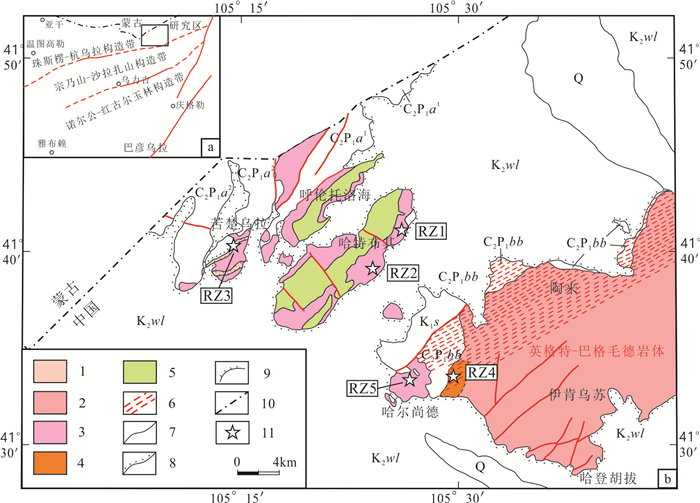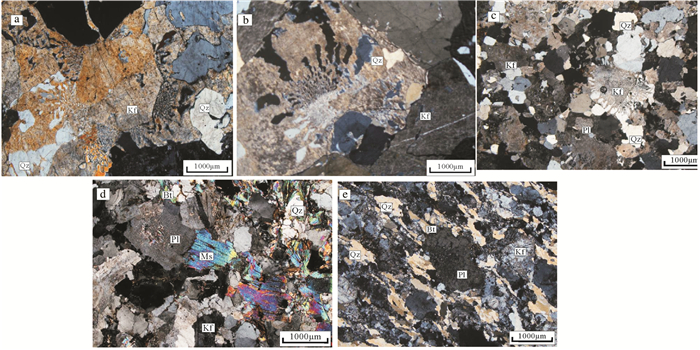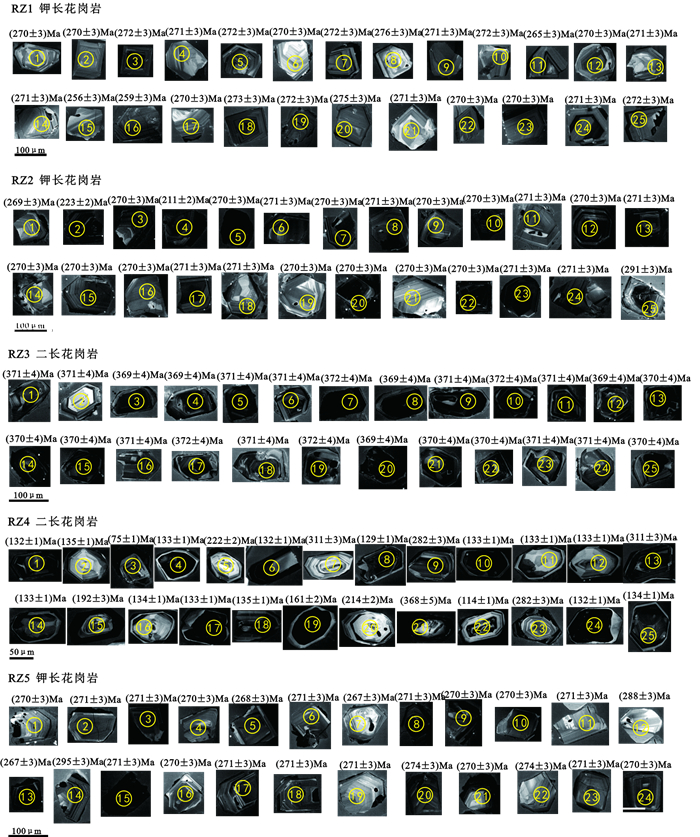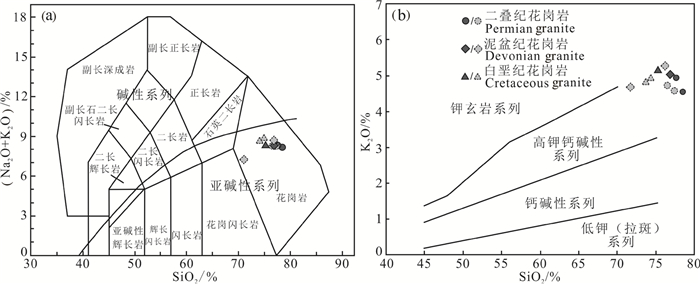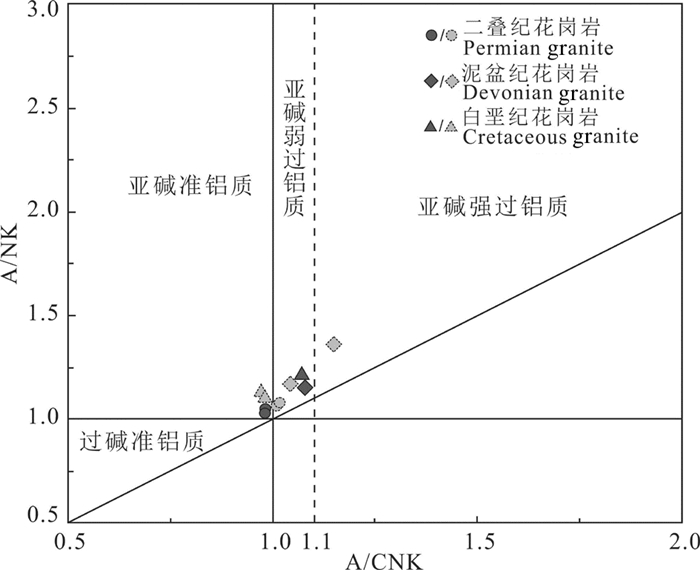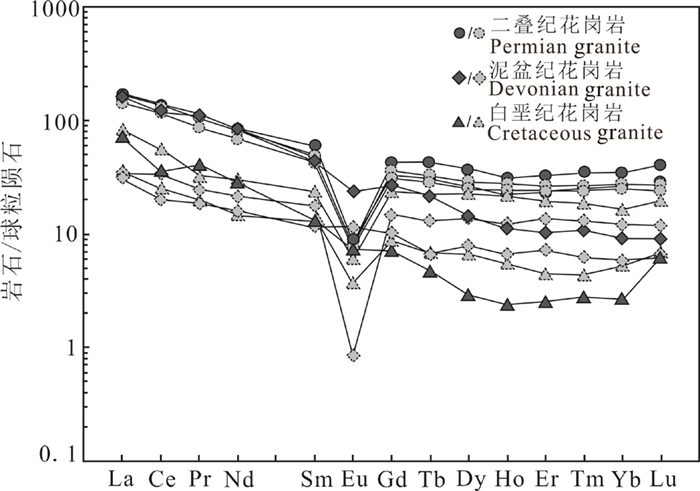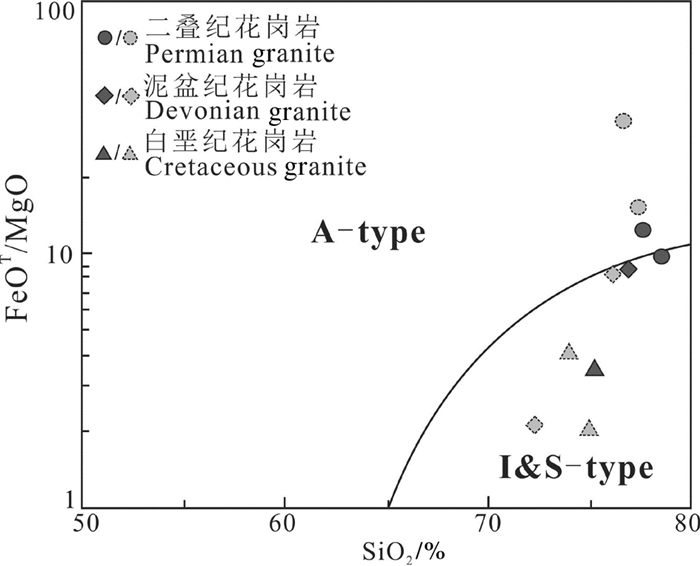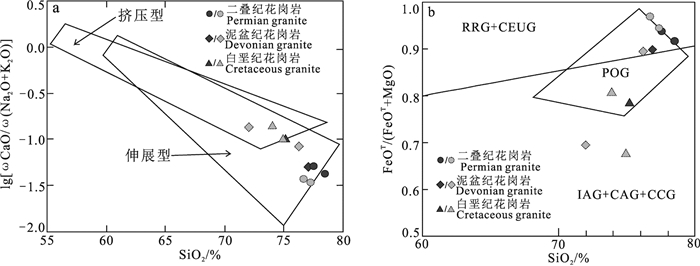Zircon U-Pb dating and geochemical characteristics of the granites in Kuchuwula-Yingba area of western Inner Mongolia
-
摘要:
锆石U-Pb定年结果表明,内蒙古西部苦楚乌拉-英巴地区花岗岩包括晚泥盆世二长花岗岩((371±2)Ma)、中二叠世钾长花岗岩((271±1)~(270±1)Ma)和早白垩世二长花岗岩((133±1)Ma)。结合前人资料,将研究区晚古生代以来的酸性岩浆活动分为4期:晚泥盆世(~371 Ma)、晚石炭世(313~311 Ma)、早-中二叠世(282~270 Ma)和早白垩世(133~130 Ma)。地球化学组成上,晚泥盆世二长花岗岩属于非典型的S型花岗岩,反映了一种后碰撞的构造背景,一方面说明珠斯楞-杭乌苏构造带在石炭纪之前已经开始出现岩浆活动,另一方面可能也恰好反映了哈萨克斯坦+塔里木+华北板块与西伯利亚板块拼合时间的下限;中二叠世钾长花岗岩则属A型花岗岩,反映了地壳伸展减薄的构造背景,与同时期区域强烈的拉张构造背景具有良好的对应关系;早白垩世二长花岗岩与晚泥盆世二长花岗岩具有相似的地球化学特征,同样反映了一种后碰撞的构造背景,与同时期区域后碰撞的拉张构造背景一致。
Abstract:Zircon U-Pb dating indicates that the granite samples collected from the Kuchuwula-Yingba area of western Inner Mongolia includes the Late Devonian monzonitic granite ((371±2)Ma), Middle Permian K-feldspar granite ((271±1)-(270±1)Ma) and Early Cretaceous monzonitic granite ((133±1)Ma). In combination with the data available, the acidic magmatic activity can be divided into 4 stages:Late Devonian (-371 Ma), Late Carboniferous (313-311 Ma), Early-Middle Permian (282-270 Ma) and Early Cretaceous (133-130 Ma). Geochemically, the Late Devonian monzonitic granites belong to the typical S-type granites, which reflects a post-collisional tectonic setting. On the one hand, these data indicate that magmatic activities occurred before the Carboniferous period in the Zhusileng-Hangwula tectonic zone; on the other hand, they probably exactly reflect the lower limit of the time when Kazakhstan + Tarim + North China plate collided with the Siberian plate. The Middle Permian K-feldspar granites belong to the A-type granites, which reflects a tectonic setting of the crustal extension, having a good correspondence with the strong extension environment of this region in the same period. The geochemical characteristics of the Early Cretaceous monzonitic granites are similar to the features of Late Devonian monzonitic granite, also suggesting a post-collisional tectonic setting in accord with the post-collisional and extensional environment of this region in the same period.
-
1. 引言
锶作为岩石圈上部含量最大的微量元素(胡进武等,2004;黄奇波等,2011),广泛存在于自然界中但分布非常不均,锶的分布状态及其存在形态受到自然条件、人类活动等多种因素的影响,导致锶在分布上富集或贫乏(Comar et al., 1957; 范伟等2010)。在不同的时期、不同岩性的基岩地层中锶元素的丰度存在明显的差异性,一般在海相沉积的碳酸盐岩中锶的丰度最高,在含锶矿物的闪长岩、花岗岩、黏土岩以及碳酸盐岩中,锶含量相对比较富集,黏土、砂中锶的丰度最低(刘庆宣等,2004)。作为微量元素,锶主要存在于各种造岩矿物和副矿物中,也能形成一些独立的矿物,主要为存在于碳酸盐岩中的菱锶矿(SrCO3)和天青石(SrSO4),同时文石、方解石、钙长石及石膏等矿物中亦常见锶置换钙的类质同像现象(Clow et al., 1997;文冬光等,1998)。岩石中的锶是地下水中锶的主要物质来源,锶在赋存母岩中主要经风化、淋滤后在地下水流作用下进行迁移转化(文冬光等,1998;康志强等,2011;苏春田等, 2017a, b),进而进入人类及其他动植物的物质循环。前人研究表明,地下水中锶的分布与富集受渗流地层岩性、溶滤强度、水化学条件(王增银等,2003;祁晓凡等,2009;范伟等, 2010)等因素的影响。目前,各国根据锶的含量及其生理医学作用制定了锶矿泉水的标准,参照饮用天然矿泉水国家标准(GB8537- 2016),地下水的质量浓度达到0.2mg/L,可命名为富锶矿泉水,规定的限值为5mg/L。岩溶水作为山区居民主要饮用的水源,关乎百姓的生活与饮食健康,因而查明地下水中锶的分布状态,揭示锶的动态变化,分析锶的富集规律,具有较大的研究意义与实际价值。
前人对富锶地下水的研究多集中在赋存条件、水质评价等方面,多集中在非岩溶地区(孙岐发等,2019),针对西南岩溶区富锶地下水的研究还较少(祁晓凡等,2009;康志强等,2011;苏春田等, 2017a, b),针对三峡岩溶区的研究则更少。本文选取湖北秭归地区两个岩溶流域为研究区,以岩溶水系统为单元,从锶的物质来源条件入手,分析岩溶水系统中锶的水岩作用过程,研究不同含水岩组、不同水流条件下地下水中锶的分布与富集特征,探讨宜昌三峡岩溶去地下水中锶富集的条件与规律。
2. 研究区概况
2.1 自然地理概况
本文主要针对秭归地区的茅坪河和九畹溪两个岩溶流域开展研究。研究区地处长江之滨、西陵峡畔、清江以北,属于中国地形第二、三阶梯的过渡地带,为川东褶皱与鄂西山地交汇地,境内山脉为大巴山、巫山余脉,地形起伏较大。该地区属于亚热带季风气候,气候温暖、降雨充沛,年降雨量在900~1200 mm,其中汛期降雨量占绝大部分,受季风气候和山峦起伏的影响,降雨量的季节变化和空间差异明显,小气候特征比较显著。秭归县位于鄂西褶皱山地,西南高东北低,平均海拔高程千米以上,山峰耸立,河谷深切,相对高差一般在500~1300 m。其中中低山区多分布于秭归盆地周边,斜坡倾角介于15~25°,面积960 km2;大于25°以上的斜坡主要分布在长江峡谷区、中高山向中低山过渡地带,陡缓变化较大,多形成陡崖。
2.2 地质概况
研究区地处黄陵穹隆西南缘,自北东向西南从侵入岩体、前震旦纪到三叠纪地层连续出露且较齐全,区内南沱组角度不整合于侵入岩与变质岩基底之上,第四系与下伏地层为角度不整合,其余地层之间均为整合与平行不整合接触关系(南沱组与陡山沱组呈平行不整合,纱帽组与云台观组呈平行不整合)。区域内地层主要是以沉积岩为主,累计沉积岩岩层最大厚度约7567 m,其中碳酸盐岩总厚度达到3443 m,占沉积岩总厚度的45.5%,碳酸盐岩地层主要有震旦系,寒武系、奥陶系、志留系、二叠系及三叠系,岩性以灰岩、白云岩为主,非碳酸盐岩地层有志留系、泥盆系、白垩系,岩性以碎屑岩为主,尤以仙女山一带的白垩系的碎屑砾岩、砂岩为特殊,常常发育有可溶性砾岩裂隙孔洞水。
2.3 岩溶含水系统划分
前人在进行岩溶含水系统划分过程中,主要考虑了含水岩组、空间介质结构、组合特征、岩溶水径流方式、埋藏条件等因素(裴建国等,2008; 梁永平等,2015)。秭归地区属于南方岩溶的范畴,多种地层组合特征、构造条件下发育多样的岩溶水系统,既发育有管道裂隙集中排泄型系统、也有裂隙分散排泄型岩溶水系统。根据区域地层的含水性分析,大致可划分为3个岩溶含水系统(图 1):上震旦岩溶含水系统(Z2d、Z2∈1d)、下寒武—奥陶岩溶含水系统(∈1t、∈1sl、∈2q、∈2O1l、O1n、O1g、O2-3b)、石炭—三叠岩溶含水系统(P1q、P1m、P2w、T1d、T2j),进一步可细分为7个岩溶含水子系统(表 1)。本文依据空间结构、含水介质、排泄方式、代表水流、标高、流量等特征数据,并结合野外调查资料,对岩溶子含水单元排泄特征进行整理划分(表 1)。
表 1 岩溶含水子系统的介质结构及排泄特征Table 1. Structure and drainage characteristics of karst water-bearing units
3. 样品采集与测试
3.1 样品采集与处理
2016—2018年期间,本文依托中国地质调查局二级项目“宜昌长江南岸岩溶流域水文地质环境地质调查”,系统地采集了研究区泉水、典型断面地表水样品,对重点岩溶泉点进行月度监测,并选送测区内主要含水岩组的岩样进行岩石矿物组成分析。针对不同岩溶水系统,选取了31组岩溶泉点作为长期监测点(长观站)(图 1),用于分析地下水的动态变化规律。本文的研究数据来源于区域水文地质调查,及31个岩溶泉长期监测点(长观站)月度样采集,共整理了415组水样数据,93组岩矿分析数据,基于此对锶的分布特征进行分析。
水样采集采用600 mLPVC瓶,现场用水样涮洗3次,同时对水样水温、pH、电导率、流量等指标进行现场测定。此后样品在12 h内送回室内,采用《中华人民共和国地质矿产行业标准DZ/T 0064.49- 93地下水水质检验方法》酸碱滴定法测试并计算碱度。同时将水样用孔径0.45 μm的醋酸纤维膜过滤后,分装于2个50 mLPET瓶中分别用于阴阳离子测试,其中阳离子测试样会使用分析纯HNO3酸化至pH<2,阴离子样则不加处理。
3.2 样品测试
水化学样品的测试在中国地质大学(武汉)地质调查研究院实验中心完成,阴离子由戴安离子色谱仪ICS2100测试,阳离子由赛默飞公司生产的ICP-OES(ICAP6300)测试;岩石样品矿物组成测试在澳实分析检测(广州)有限公司测试完成,锶等矿物组分均采用封闭酸溶-电感耦合等离子体质谱法(ICP-MS)测试。
4. 分析与讨论
4.1 锶的物源条件分析
通过对93组岩矿分析数据分析可知,不同地质年代的沉积地层中锶的含量大不相同(表 2),在震旦系地层中,灯影组地层锶含量比陡山沱组高,灯影组锶含量可达到2900 μg/g,均值为1121 μg/g,且组内不同段含量差异明显,如灯影组二段的白云质灰岩中锶含量介于800~2600 μg/g,其含量较一段和三段的白云岩大,灯影组地层整体变异系数为88.2%(n=10);寒武系上统娄山关组白云岩中锶含量介于77~2500 μg/g,变异系数为62.5%(n=11),锶含量均值大但分布上存在差异性;奥陶系地层锶含量均不高,介于100~400 μg/g,变异系数相对较低;嘉陵江组地层锶的含量较高,均值为2861 μg/g,变异系数也较高,为137.3%(n=17)。
表 2 秭归岩溶地层中锶含量概况统计Table 2. Statistics of Sr contents in karst strata in the Zigui area
可知,秭归地区富锶地层主要为灯影组、娄山关组、嘉陵江组。从沉积相来看,上述沉积地层均为干旱气候条件下碳酸盐台地浅滩、潮坪-潟湖沉积(徐长昊,2016),为封闭性较好的沉积环境,是蒸发沉积富锶地层发育的良好条件。
同时对区内浅层包气带内岩样分析发现,表层岩石中天青石矿物较少,锶含量偏低且与CaO的相关性较好,而与MgO、SO3、Al2O3的相关性一般。主要是由于表层岩石受到较强的淋滤作用而导致锶的流失,此外浅循环系统中的锶会以类质同像形式存在于方解石矿物中。
对由钻孔揭露深层封闭地层岩样分析发现,锶主要以天青石形式存在,常常与石膏矿物共存。如钻孔ZK05揭露的娄山关组地层中,锶含量普遍较高且与SO3有较好的相关性(R2=0.737,n=10)。另在对钻孔ZK03揭露的奥陶系岩心分析发现,随着MgO含量的增大,岩性逐渐白云岩化,同时锶含量逐渐减小(图 2);此外,锶的含量会随着碳酸盐中泥质含量的增大(SiO2含量增大)而减小(图 2)。
4.2 锶的水岩作用过程分析
通过对茅坪河与九畹溪两个流域岩溶地下水样分析,从富锶水化学类型、水岩作用程度、物理化学条件等方面,对该区地下水锶分布与富集展开讨论。
针对研究区所采集的415组水样,从Piper三线图(图 3)来看,地下水中锶含量大于2 mg/L时,水中阳离子以Ca2+、Mg2+为优势离子,阴离子以SO42-为主;地下水中锶含量在0.70~10 mg/L时,水中阳离子以Na+为主,阴离子以Cl-为主;地下水中锶含量小于0.70 mg/L时,水中阴离子以HCO3-为主。因此,锶浓度相对较高的地下水化学类型主要包括SO4型和Cl型,其中尤以SO4型地下水的锶浓度最高。
岩溶地下水中离子组分主要来源于对母岩的溶滤作用,其决定着地下水中主要水化学过程(康志强等,2011; 苏春田等,2017a)。母岩中锶含量影响着水流系统地下水中锶的分布(文冬光等,1998;苏春田等,2017b)。地下水中锶离子主要来源于富锶矿物(天青石、菱锶矿),赋存在方解石、文石及白云石类质同像形态的锶,以及铝硅酸盐中的锶等的溶解(徐兴国,1984),具体的化学反应方程式如下:

(1) 
(2) 
(3) 表层岩溶泉可反映局部水流系统的水化学特征。基于所采集的334处表层岩溶泉,绘制出研究区锶在表层岩溶水中的分布规律,发现全区存在5处富锶地下水分布区(图 4),且这些富锶地下水分布与富锶地层的分布表现出一致性,二叠系阳新组岩溶水,三叠系嘉陵江组岩溶水,寒武系娄山关组岩溶水,寒武系水井沱组岩溶水及震旦系灯影组岩溶水。其中杨新组表层岩溶水中Sr含量介于0.26~ 0.76 mg/L;嘉陵江组介于0.23~0.60 mg/L;娄山关组介于0.13~0.43 mg/L;水井沱组与灯影组介于0.22~0.72 mg/L。
对于排泄区,选取研究区内4处锶含量较高的地层中出露的地下水点为例,即白龙潭、龙洞、迷宫泉和龙王洞(表 1)。从锶离子与硫酸根离子、重碳酸根离子的浓度关系(图 5)发现,嘉陵江组白龙潭岩溶泉水锶含量较高,与硫酸根离子有较好的一致性(R2=0.707,n=5),另知嘉陵江组岩矿分析中SO3含量较高,反映出在该泉域的径流途径上有天青石的存在;娄山关组迷宫泉与重碳酸根离子和硫酸根离子均呈现较好的相关性(R2=0.668,n=10;R2= 0.768,n=13),反映出径流途径中存在两种富锶矿物溶解。此外,针对地下水中丰、枯两季表现出差异性(图 5),主要是由于研究区具有典型南方岩溶管道-裂隙水系统,地下水径流路径和径流时间短、水岩作用不充分(罗明明等,2015),表现出枯季地下水中锶含量普遍比丰水期的要高。由上可知,岩溶水中锶离子含量与各岩溶水系统中富锶矿物含量密切相关,流经的地层岩性差异导致各岩溶水流系统表现出不同的水岩作用过程,或受石膏、天青石矿物溶解的影响,或受菱锶矿溶解的影响,或受多种锶源的混合补给。
4.3 地下水流系统中锶的分布规律
对于锶在多级水系系统中的分布规律,本文以泗溪流域庙坪—鱼泉洞多级水流系统为例(图 1b),不同级次的地下水中锶含量及饱和程度易表现出差异性(表 3,图 6)。庙坪洼地表层岩溶泉为局部水流系统,锶含量均值为0.08 mg/L,si_Str与si_Cel均比较低(表 3),多为方解石中类质同像锶的溶解释放;鱼泉洞泉水为中间水流系统,地下水锶含量均值为0.22 mg/L,si_Stron与SI_Cel相比于局部水流系统稍高但未达到饱和(表 3),但冬季其锶的饱和指数相对夏季要高,主要由于冬季水流滞缓,水岩作用相对充分(表 3);以钻孔ZK04揭露的区域水流系统,其锶均值在2.33 mg/L,si_Str、si_Cel、si_Cal、si_Dol均趋于饱和(图 6)。可知地下水与母岩水岩相互作用的时间与水流路径长短决定了地下水中富锶矿物的饱和程度及地下水中锶含量(张群利等,2011;苏春田等,2017a)。
表 3 不同级次水流水化学信息统计表Table 3. Hydrochemistry of different water flow levels
此外,通过对钻孔ZK04及钻孔ZK05中锶含量分析(表 3,图 6),发现两者锶离子浓度均很大。在两孔钻进施工中,均有H2S与CH4等还原性气体溢出,且岩心中有机炭的含量相对较高,尤其是ZK05岩矿组分中发现有单质S存在。推知两孔均混有碳酸盐岩和硫酸盐岩(富含大量的石膏),且均为相对封闭的还原环境。
在这种封闭缺氧还原环境中,地下水中的SO42-在有机炭和脱硫细菌作用下,容易发生脱硫酸作用(刘硕等,2016),其化学反应式为:

(4) 
(5) 当地层中含有大量铁的时候S2-便会与铁结合,逐渐生成黄铁矿,而硫化氢气体极易溶于水(溶解比例约为1∶3),在氧气充足的时候,H2S会被氧化成硫酸与碳酸盐结合形成石膏矿物沉淀,但当氧气不足的时候,少部分的H2S会被氧化成单质S,更大一部分仍以气体的形式存在于封闭的还原条件中,这也就是ZK05孔岩心组分中单质S存在的原因。硫酸根离子的转化,促进了石膏、天青石的溶解过程,致使地下水中锶离子富集,甚至使天青石溶解达到饱和,同时菱锶矿的溶解也增大了地下水中锶的含量(罗璐等,2015)。
5. 结论
本文通过对秭归岩溶流域锶的分布与迁移进行分析,得到以下结论:
(1)研究区内嘉陵江组、娄山关组、灯影组地层中的锶含量最高,代表着潮坪-潟湖沉积相;区内浅层岩石中天青石矿物较少,锶含量偏低;深层封闭地层岩样中锶主要以天青石形式存在,常常与石膏矿物共存。
(2)富锶岩溶水的水化学类型主要包括SO4型和Cl型,尤以SO4型地下水的锶浓度最高;母岩中锶的含量决定了地下水中锶的浓度,且锶主要通过溶滤作用进入地下水中。
(3)地下水水流系统中水岩作用程度及地下水的滞留时间均影响地下水中锶的浓度,浅循环岩溶地下水流系统中锶均未达到饱和,少数深循环区域地下水流系统中锶浓度趋近饱和状态。对于富含石膏、天青石的封闭还原环境有利于地下水中锶的富集。
-
图 1 研究区大地构造位置(a)和地质简图(b)
(a,据史兴俊等,2014修改;b,据内蒙古自治区地质调查院,2004修改)1—泥盆纪二长花岗岩;2—石炭纪花岗岩;3—二叠纪钾长花岗岩;4—白垩纪二长花岗岩;5—辉长岩;6—韧性变形带;7—地质界线;8—角度不整合界线;9—花岗岩体超动接触界线;10—国界线;11—采样点;Q—第四系;K2wl—乌兰苏海组;K1s—苏红图组;C2P1a2—阿木山组二岩段;C2P1a1—阿木山组一岩段;C2P1bb—本巴图组
Figure 1. Tectonic location (a) and geological sketch map (b) of the study area
(a, modified from Shi et al., 2014; b, modified from Geological Survey Institute of Inner Mongolia, 2004) 1−Monzonitic granite of Devonian; 2−Granite of Carboniferous; 3—K−feldspar granite of Permian; 4−Monzonitic granite of Cretaceous; 5−Gabbro; 6−Ductile deformation; 7−Geological boundary; 8−Angular unconformity; 9−Overdynamic contact boundary of granite; 10−National boundary line; 11−Sampling point; Q−Quaternary; K2wl−Wulansuhai Formation; K1s−Suhongtu Formation; C2P1a2−the second member of Amushan Formation; C2P1a1−the first member of Amushan Formation; C2P1bb−Benbatu Formation
图 2 研究区花岗岩镜下显微照片
a—晚古生代钾长花岗岩(RZ1);b—晚古生代钾长花岗岩(RZ2);c—晚古生代钾长花岗岩(RZ5);d—晚古生代二长花岗岩(RZ3);e—中生代二长花岗岩(RZ4);Qz—石英;Kf—钾长石;Pl—斜长石;Bt—黑云母;Ms—白云母(均为正交镜下拍摄)
Figure 2. Microphotographs of granites in the study area
a−K-feldspar granite of late Paleozoic (RZ1);b−K-feldspar granite of late Paleozoic (RZ2);c−K-feldspar granite of late Paleozoic (RZ5); d−Monzonitic granite of late Paleozoic; e−Monzonitic granite of Mesozoic; Qz−Quartz; Kf− K-feldspar; Pl−Plagioclase; Bt−Biotite; Ms−Muscovite (crossed nicols)
图 5 SiO2-Na2O+K2O图(a,据Middlemost,1994)和SiO2-K2O图(b,据Martin et al., 2005)
Figure 5. SiO2-Na2O+K2O(a, after Middlemost, 1994) and SiO2-K2O(b, after Martin et al., 2005) diagram
图 6 A/CNK-A/NK图(据Maniar and Piccoli, 1989)
Figure 6. A/CNK-A/NK diagram(after Maniar and Piccoli, 1989)
图 7 球粒陨石标准化稀土元素配分曲线图(标准化值据Boynton,1984)
Figure 7. Chondrite-normalized REE patterns(normalized values after Boynton, 1984)
图 8 FeOT/MgO-SiO2图(据Whlane et al., 1987)
Figure 8. FeOT/MgO-SiO2 diagram (after Whlane et al., 1987)
图 9 lg[ω(CaO)/ω(K2O+Na2O)]-SiO2图(a,据Brown,1982)和FeOT(/ FeOT+MgO)-SiO2图(b,据Maniar and Piccoli, 1989)
IAG—岛弧花岗岩类;CAG—大陆弧花岗岩类;CCG—大陆碰撞花岗岩类;POG—造山期后花岗岩类;RRG—与裂谷有关的花岗岩类;CEUG—与陆内造陆隆起有关的花岗岩类
Figure 9. lg[ω(CaO)/ω(K2O+Na2O)] -SiO2(a, after Brown, 1982) and FeOT/(FeOT+MgO)-SiO2 diagram (b, after Maniar and Piccoli, 1989)
IAG-Island arc granitoids; CAG-Continental arc granitoids; CCG-Continental collision granitoids; POG-Postorogenic granitoids; RRG-Riftrelated granitoids; CEUG-Continental epeirogenic uplift granitoids
表 1 锆石U-Pb年龄分析结果
Table 1 Zircon U-Pb test results

表 2 主量(%)和稀土(10-6)元素分析结果
Table 2 Major (%) and rare earth (10-6) elements test results

-
Anderson T. 2002. Correction of common lead in U-Pb analyses that do not report 204Pb[J]. Chemical Geology, 192:59-79. doi: 10.1016/S0009-2541(02)00195-X
Bai Xinhui, Xu Zhongyuan, Liu Zhenghong, Xin Houtian, Wang Wanqiong, Wang Xin, Lei Congcong. 2015. Zircon U-Pb dating, geochemistry and geological significance of the Early Silurian plutons from the southeastern margin of the Central Asian Orogenic Belt[J]. Acta Petrologica Sinica, 31(1):67-79(in Chinese with English abstract). http://www.researchgate.net/publication/279318765_Zircon_U-Pb_dating_geochemistry_and_geological_significance_of_the_Early_Silurian_plutons_from_the_southeastern_margin_of_the_Central_Asian_Orogenic_Belt
Boynton W V. 1984. Cosmochemistry of the rare earth elements:Meteorite studies[J]. Developments in Geochemistry, 2(2):63-114. http://www.sciencedirect.com/science/article/pii/B9780444421487500083
Chen Xijie, Zhang Kuihua, Zhou Jian. 2016. Geochronology and geochemistry characteristics of the Early Permian monzogranite and dioritic enclaves of East Tianshan and their tectonic implications[J]. Acta Geologica Sinica, 90(9):2334-2354(in Chinese with English abstract). http://en.cnki.com.cn/Article_en/CJFDTOTAL-DZXE201609018.htm
Collins W J, Beams S D, White A J R, Chappell B W. 1982. Nature and origin of A-type granites with particular reference to southeastern Australia[J]. Contributions to Mineralogy and Petrology, 80(2):189-200. doi: 10.1007/BF00374895
Dong Lianhui, Qu Xun, Zhao Tongyang, Xu Shiqi, Zhou Ruhong, Wang Kezhuo, Zhu Zhixin. 2012. Magmatic sequence of Early Palaeozoic granitic instrusions and its tectonic implications in north Altay orogen, Xingjiang[J]. Acta Petrologica Sinica, 28(8):2307-2316(in Chinese with English abstract). http://www.oalib.com/paper/1475601
Geng Jianzhen, Zhang Jian, Li Huaikun, Li Huimin, Zhang Yongqing, Hao Shuang. 2012. Ten-micron-sized zircon U-Pb dating using LA-MC-ICP-MS[J]. Acta Geoscientica Sinica, 33(6):877-884(in Chinese with English abstract). http://www.oalib.com/paper/1560506
Guo Xiyun, Sun Huashan, Dong Aiguan, Ren Jianxun, Xu Ruiying, Gao Bo. 2019. The genesis and dating of the Early Permian granitic rock in the north of Xilin Hot, Inner Mongolia[J]. Geology in China, 46(6):1396-1409(in Chinese with English abstract).
Han Baofu, Guo Zhaojie, He Guoqi. 2010a. Timing of major suture zones in North Xinjiang, China:Constrains from stiching plutons[J]. Acta Petrologica Sinica, 26(8):2233-2246(in Chinese with English abstract).
Han Baofu, Zhang Chen, Zhao Lei, Ren Rong, Xu Zhao, Chen Jiafu, Zhang Lei, Zhou Yinzhang, Song Biao. 2010b. A preliminary study of granitoids in western Inner Mongolia[J]. Acta Petrologica et Mineralogica, 29(6):741-749(in Chinese with English abstract). http://en.cnki.com.cn/Article_en/CJFDTotal-YSKW201006011.htm
He Fubing, Wei Bo, Xu Jixiang, Sun Yonghua, Li Ruijie. 2017. Ages, origin and geological implications of the volcanic rocks in the Baoligaomiao Formation of East Ujimqin Banner, Inner Mongolia[J]. Geology in China, 44(6):1159-1174(in Chinese with English abstract). http://www.researchgate.net/publication/324014115_Ages_origin_and_geological_implications_of_the_volcanic_rocks_in_the_Baoligaomiao_Formation_of_East_Ujimqin_Banner_Inner_Mongolia
Li Junjian. 2006. Regional Metallogenic System of Alashan Block in Inner Mongolia Autonomous Region[D]. Beijing: China University of Geoscience, 1-35(in Chinese with English abstract).
Li Pengwu, Zhang Shihong, Gao Rui, Li Haiyan, Zhao Qingle, Li Qiusheng, Guan Ye. 2012. New Upper Carboniferous Lower Permian paleomagnetic results from the Central Inner Mongolia and their geological implications[J]. Journal of Jilin University(Earth Science Edition), 42(S1):423-440(in Chinese with English abstract). http://www.researchgate.net/publication/279624901_New_Upper_Carboniferous-lower_Permian_paleomagnetic_results_from_the_central_Inner_Mongolia_and_their_geological_implications
Liu Feng, Yang Fuquan, Mao Jingwen, Chai Fengmei, Geng Xinxia. 2009. Study on chronology and geochemistry for Abagong granite in Altay orogen[J]. Acta Petrologica Sinica, 25(6):1416-1425(in Chinese with English abstract). http://en.cnki.com.cn/Article_en/CJFDTOTAL-YSXB200906012.htm
Liu Qiaofeng. 2015. Petrogenesis, Geochemistry and Tectonic Implication of Guaizihu Composite Rock Body in Alxa of Inner Mongolia[D]. Xi'an: Chang'an University, 16-44(in Chinese with English abstract).
Liu Rui, Yang Zhen, Xu Qidong, Zhang Xiaojun, Yao Chunliang. 2016. Zircon U-Pb ages, elemental and Sr-Nb-Pb isotopic geochemistry of the Hercynian granitoids from the southern segment of the Da Hinggan Mts.:Petrogenesis and tectonic implications[J]. Acta Petrologica Sinica, 32(5):1505-1528(in Chinese with English abstract).
Liu Yongsheng, Hu Zhaochu, Gao Shan, Detlef G, Xu Juan, Gao Changgui, Chen Haihong. 2008. In situ analysis of major and trace elements of anhydrous minerals by LA-ICP-MS without applying an internal standard[J]. Chemical Geology, 257(1/2):34-43. http://www.sciencedirect.com/science/article/pii/S0009254108003501
Ludwig K R. 2003. User's Manual for Isoplot 3.00. A geochronological Toolkit for Microsoft Excel[M]. Berkeley:Berkeley Geochronology Center Special Publication, 1-70. http://www.researchgate.net/publication/303107803_User's_manual_for_Isoplot_36_A_geochronological_toolkit_for_microsoft_excel_Berkeley_Geochronology_Center
Lv Bin, Wang Tao, Tong Ying, Zhang Lei, Yang Qidi, Zhang Jianjun. 2017. Spatial and temporal distribution of magmatic-hydrothermal ore deposits in the eastern Central Asia Orogen Belt and its tectonic settings[J]. Journal of Jilin University(Earth Science Edition), 47(2):305-343(in Chinese with English abstract). http://en.cnki.com.cn/Article_en/CJFDTOTAL-CCDZ201702001.htm
Maniar P D, Piccoli P M. 1989. Tectonic discrimination of granitoids[J]. The Geological Society of America Bulletin, 101(5):635-643. doi: 10.1130/0016-7606(1989)101<0635:TDOG>2.3.CO;2
Martin H, Smiithies R H, Rapp R, Moyen J F, Champion D. 2005. An overview of adakite, tonalite-trondhjemite-granodiorite(TTG), and sanukitoid:Relationships and some implications for crustal evolution[J]. Lithos, 79(1/2):1-24. http://www.sciencedirect.com/science/article/pii/S002449370400266X
Middlemost E A K. 1994. Naming materials in the magma/igneous rock system[J]. Earth-Science Reviews, 37(3/4):215-224. http://www.sciencedirect.com/science/article/pii/0012825294900299
Pruner P. 1987. Palaeomagnetism and palaeogeography of Mongolia in the Cretaceous, Permian and Carboniferous:Preliminary data[J]. Tectonophysics, 139(1/2):155-167. http://www.sciencedirect.com/science/article/pii/0040195187902046
Şengör A M C, Natal'In B A, Burtman V S. 1993. Evolution of theAltaid tectonic collage and Palaeozoic crustal growth in Eurasia[J].Nature, 364(6435):299-307. doi: 10.1038/364299a0
Shi Xingjun, Zhang Lei, Wang Tao, Xiao Xuchang, Tong Ying, Zhang Jianjun, Geng Jianzhen, Ye Ke. 2014. Geochronology and geochemistry of the intermediate-acid intrusive rocks from Zongnaishan area in northern Alxa, Inner Mongolia, and their tectonic implications[J]. Acta Petrologica et Mineralogica, 33(6):989-1007(in Chinese with English abstract). http://en.cnki.com.cn/Article_en/CJFDTOTAL-YSKW201406001.htm
Sylvester P J. 1989. Post-collisional alkaline granites J[J]. The Journal of Geology, 97:261-280. doi: 10.1086/629302
Tao Wang, Yadong Zheng, Tianbin Li, Yongjun Gao. 2004. Mesozoic granitic magmatism in extensional tectonics near the Mongolian border in China and its implications for crustal growth[J]. Journal of Asian Earth Sciences 23(2004):715-729. http://onlinelibrary.wiley.com/resolve/reference/ADS?id=2004JAESc..23..715W
Tong Ying, Hong Dawei, Wang Tao, Wang Shiguang, Han Baofu. 2006. TIMS U-Pb zircon ages of Fuyun post-orogenic linear granite plutons on the southern margin of Altay orogenic belt and their imlications[J]. Acta Petrologica et Mineralogica, 25(2):85-89(in Chinese with English abstract). http://www.zhangqiaokeyan.com/academic-journal-cn_acta-petrologica-mineralogica_thesis/0201254452027.html
Tong Ying, Wang Tao, Hong Dawei, Dai Yajian, Han Baofu, Liu Xiaoming. 2007. Ages and origin of the Early Devonian granites from the north part of Chinese Altai Mountains and its tectonic implications[J]. Acta Petrologica Sinica, 23(8):1933-1944(in Chinese with English abstract).
Wang Tao, Tong Ying, Li Shan, Zhang Jianjun, Shi Xingjun, Li Jinyi, Han Baofu, Hong Dawei. 2010. Spatial and temporal variations of granitoids in the Altay orogen and their impications for tectonic setting and crustal growth:Perspectives from Chinese Altay[J]. Acta Petrologica et Mineralogica, 29(6):595-618(in Chinese with English abstract). http://en.cnki.com.cn/Article_en/CJFDTOTAL-YSKW201006002.htm
Wang Tao, Zhang Lei, Guo Lei, Wang Xiaoxia, Li Shan, Feng Chengyou, Tong Ying, Zhang Jianjun, Zhang Hongrui, Zhang Chengli, Mao Jianren, Yang Qidi. 2014. The progress of the preliminary compilation of Map of Mesozoic Granitoid of Asia and the research on related key issues[J]. Acta Geoscientica Sinica, 35(6):655-672(in Chinese with English abstract). http://en.cnki.com.cn/Article_en/CJFDTOTAL-DQXB201406001.htm
Wang Tao, Zheng Yadong. 2002. Mesozoic progressive transition from overthrusting to extension in the Sino-Mongolian border region and crustal-scale tangential shear[J]. Acta Geologica Sinica, 21(4-5):232-237(in Chinese with English abstract). http://en.cnki.com.cn/Article_en/CJFDTotal-ZQYD2002Z1008.htm
Wang Tingyin, Gao Junping, Wang Jinrong, Wu Jiahong. 1998. Magmatism of collisional and post-orogenic period in northern Alxa region in Inner Mongolia[J]. Acta Geologica Sinica, 72(2):126-137(in Chinese with English abstract). http://www.researchgate.net/publication/291105582_Magmatism_of_collision_and_post-orogenic_period_in_northern_Alaxa_Region_in_Inner_Mongolia
Wang Tingyin, Liu Jinkun, Wang Shizheng, Wu Jiahong. 1993. Late Paleozoic extension and tectono-magmatic evolution in the Sino-Mongolia border region in the northern part of Alxa[J]. Regional Geology of China, 12(4):317-326(in Chinese with English abstract).
Whalen J B, Currie K L, Chappell B W. 1987. A-type granites:geochemical characteristics, discriminations and petrogenesis[J]. Contributions to Mineralogy and Petrology, 95:407-419. doi: 10.1007/BF00402202
Windley B F, Alexeiev D, Xiao W J, Kröner A, Badarch G. 2007. Tectonic models for accretion of the Central Asian Orogenic Belt[J]. Journal of the Geological Society, 164(12):31-47. http://petrology.oxfordjournals.org/cgi/ijlink?linktype=abst&journalcode=gsjgs&resid=164/1/31
Wu Fuyuan, Li Xianhua, Yang Jinhui, Zheng Yongfei. 2007. Discussions on the petrogenesis of granites[J]. Acta Petrologica Sinica, 23(6):1217-1238(in Chinese with English abstract). http://www.researchgate.net/publication/279707410_Discussion_on_the_petrogenesis_of_granites
Wu Tairan, He Guoqi. 1993. Tectonic units and their fundamental characteristics on the northern margin of the Alxa Block[J]. Acta Geologica Sinica, 67(2):97-108(in Chinese with English abstract). http://www.cnki.com.cn/Article/CJFDTotal-DZXW199304000.htm
Xiao Wenjiao, Windley B F, Allen M B, Han Chunming. 2013. Paleozoic multiple accretionary and collisional tectonics of the Chinese Tianshan orogenic collage[J]. Gondwana Research, 23(4):1316-1341. doi: 10.1016/j.gr.2012.01.012
Xie Li, Yin Haiquan, Zhou Hongrui, Zhang Weijie. 2014. Permian radiolarians from the Engeerwusu suture zone in Alxa area of Inner Mongolia and its geological significance[J]. Geological Bulletin of China, 33(5):691-697(in Chinese with English abstract). http://en.cnki.com.cn/Article_en/CJFDTOTAL-ZQYD201405010.htm
Xu Bei, Zhao Pan, Bao Qingzhong, Zhou Yongheng, Wang Yanyang, Luo Zhiwen. 2014. Preliminary study on the pre-Mesozoic tectonic unit division of the Xing Meng Orogenic Belt(XMOB)[J]. Acta Petrologica Sinica, 30(7):1841-1857(in Chinese with English abstract). http://qikan.cqvip.com/Qikan/Article/Detail?id=661910910
Xu Xueyi, He Shiping, Wang Hongliang, Zhang Erpeng, Chen Juanlu, Sun Jiming. 2008. Tectonic framework of North Qinling Mountain and North Qilian Mountain conjunction area in Early Paleozoic:A study of the evidences from strata and tectonic-magmatic events[J]. Northwestern Geology, 41(1):1-21(in Chinese with English abstract). http://www.cnki.com.cn/article/cjfdtotal-xbdi200801000.htm
Yuan W, Yang ZY. 2015. The Alashan Terrane did not amalgamate with North China block by the Late Permian:evidence from Carboniferous and Permian paleomagnetic results[J]. Journal Asian Earth Sciences, 104:145-159. doi: 10.1016/j.jseaes.2014.02.010
Zhang Qi, Ran hao, Li Chengdong. 2012. A-type granite:What is the essence?[J]. Acta Petrologica et Mineralogica, 31(4):621-626(in Chinese with English abstract). http://en.cnki.com.cn/Article_en/CJFDTOTAL-YSKW201204015.htm
Zhao P, Chen Y, Xu B, Faure M, Shi GZ, Choulet F. 2013. Did the Paleo-Asian Ocean between North China Block and Mongolia Block exist during the late Paleozoic? First paleomagnetic evidence from central-eastern Inner Mongolia, China[J]. Journal of Geophysical Research:Solid Earth, 118:1873-1894. doi: 10.1002/jgrb.50198
Zheng Rongguo, Li Jinyi, Xiao Wenjiao, Liu Jianfeng, Wu Tairan. 2016. Discovery of Silurian pluton in the Enger Us region in the northern margin of Alxa Block[J]. Acta Geologica Sinica, 90(8):1725-1736(in Chinese with English abstract). http://www.researchgate.net/publication/331857868_Discovery_of_Silurian_Pluton_in_the_Enger_Us_Region_in_the_Northern_Margin_of_Alxa_Block
白新会, 徐仲元, 刘正宏, 辛后田, 王挽琼, 王新, 雷聪聪. 2015.中亚造山带东段南缘早志留世岩体锆石U-Pb定年、地球化学特征及其地质意义[J].岩石学报, 31(1):67-79. https://www.cnki.com.cn/Article/CJFDTOTAL-YSXB201501005.htm 陈希节, 张奎华, 周健. 2016.东天山哈密地区早二叠世花岗岩体及镁铁质包体的年代学, 岩石地球化学特征及其构造意义[J].地质学报, 90(9):2334-2354. doi: 10.3969/j.issn.0001-5717.2016.09.015 董连慧, 屈迅, 赵同阳, 徐仕琪, 周汝洪, 王克卓, 朱志新. 2012.新疆北阿尔泰造山带早古生代花岗岩类侵入序列及其构造意义[J].岩石学报, 28(8):2307-2316. https://www.cnki.com.cn/Article/CJFDTOTAL-YSXB201208002.htm 耿建珍, 张健, 李怀坤, 李惠民, 张永清, 郝爽. 2012. 10μm尺度锆石U-Pb年龄的LA-MC-ICP-MS测定[J].地球学报, 33(6):877-884. https://www.cnki.com.cn/Article/CJFDTOTAL-DQXB201206005.htm 郭喜运, 孙华山, 董挨管, 任建勋, 徐瑞英, 高博. 2019.内蒙古锡林浩特北早二叠世花岗岩类定年及成因[J].中国地质, 46(6):1396-1409. http://geochina.cgs.gov.cn/geochina/ch/reader/view_abstract.aspx?file_no=20190611&flag=1 韩宝福, 郭召杰, 何国琦. 2010a."钉合岩体"与新疆北部主要缝合带的形成时限[J].岩石学报, 26(8):2233-2246. https://www.cnki.com.cn/Article/CJFDTOTAL-YSXB201008002.htm 韩宝福, 张臣, 赵磊, 任荣, 徐钊, 陈家富, 张磊, 周印章, 宋彪. 2010b.内蒙古西部呼伦陶勒盖地区花岗岩类的初步研究[J].岩石矿物学杂志, 29(6):741-749. https://www.cnki.com.cn/Article/CJFDTOTAL-YSKW201006011.htm 何付兵, 魏波, 徐吉祥, 孙永华, 李瑞杰. 2017.内蒙古巴彦敖包地区宝力高庙组火山岩地球化学特征、锆石U-Pb年龄及地质意义[J].中国地质, 44(6):1159-1174. http://geochina.cgs.gov.cn/geochina/ch/reader/view_abstract.aspx?file_no=20170610&flag=1 李俊健. 2006.内蒙古阿拉善地块区域成矿系统[D].北京: 中国地质大学(北京), 1-35. 李朋武, 张世红, 高锐, 李海燕, 赵庆乐, 李秋生, 管烨.2012.内蒙古中部晚石炭世-早二叠世古地磁新数据及其地质意义[J].吉林大学学报(地球科学版), 42(S1):423-440. https://www.cnki.com.cn/Article/CJFDTOTAL-CCDZ2012S1051.htm 刘锋, 杨富全, 毛景文, 柴凤梅, 耿新霞. 2009.阿尔泰造山带阿巴宫花岗岩体年代学及地球化学研究[J].岩石学报, 25(6):1416-1425. https://www.cnki.com.cn/Article/CJFDTOTAL-YSXB200906012.htm 刘巧峰. 2015.内蒙古拐子湖温图高勒复式岩体地质、地球化学特征及构造意义[D].西安: 长安大学, 16-44. 刘锐, 杨振, 徐启东, 张晓军, 姚春亮. 2016.大兴安岭南段海西期花岗岩类锆石U-Pb年龄、元素和Sr-Nb-Pb同位素地球化学:岩石成因及构造意义[J].岩石学报, 32(5):1505-1528. https://www.cnki.com.cn/Article/CJFDTOTAL-YSXB201605017.htm 吕斌, 王涛, 童英, 张磊, 杨奇荻, 张建军. 2017.中亚造山带东部岩浆热液矿床时空分布特征及其构造背景[J].吉林大学学报(地球科学版), 47(2):305-343. https://www.cnki.com.cn/Article/CJFDTOTAL-CCDZ201702001.htm 史兴俊, 张磊, 王涛, 肖序常, 童英, 张建军, 耿建珍, 叶珂. 2014.内蒙古阿拉善盟北部宗乃山中酸性侵入岩年代学、地球化学及构造意义[J].岩石矿物学杂志, 33(6):989-1007. doi: 10.3969/j.issn.1000-6524.2014.06.001 童英, 洪大卫, 王涛, 王世洸, 韩宝福. 2006.阿尔泰造山带南缘富蕴后造山线形花岗岩体锆石U-Pb年龄及其地质意义[J].岩石矿物学杂志, 25(2):85-89. doi: 10.3969/j.issn.1000-6524.2006.02.001 童英, 王涛, 洪大卫, 代雅建, 韩宝福, 柳晓明. 2007.中国阿尔泰北部山区早泥盆世花岗岩的年龄、成因及构造意义[J].岩石学报, 23(8):1933-1944. doi: 10.3969/j.issn.1000-0569.2007.08.014 王涛, 童英, 李舢, 张建军, 史兴俊, 李锦轶, 韩宝福, 洪大卫. 2010.阿尔泰造山带花岗岩时空演变、构造环境及地壳生长意义——以中国阿尔泰为例[J].岩石矿物学杂志, 29(6):595-618. doi: 10.3969/j.issn.1000-6524.2010.06.002 王涛, 张磊, 郭磊, 王晓霞, 李舢, 丰成友, 许文良, 童英, 张建军, 张洪瑞, 张成立, 毛建仁, 杨奇荻. 2014.亚洲中生代花岗岩图初步编制及若干研究进展[J].地球学报, 35(6):655-672. https://www.cnki.com.cn/Article/CJFDTOTAL-DQXB201406001.htm 王涛, 郑亚东. 2002.中蒙边界中生代推覆-伸展递进转换及地壳尺度的切向剪切[J].地质学报, 21(4/5):232-237. https://www.cnki.com.cn/Article/CJFDTOTAL-ZQYD2002Z1008.htm 王廷印, 高军平, 王金荣, 吴家弘. 1998.内蒙古阿拉善北部地区碰撞期和后造山期岩浆作用[J].地质学报, 72(2):126-137. doi: 10.3321/j.issn:0001-5717.1998.02.004 王廷印, 刘金坤, 王士政, 吴家弘. 1993.阿拉善北部中蒙边界地区晚古生代拉伸作用及构造岩浆演化[J].中国区域地质, 12(4):317-326. https://www.cnki.com.cn/Article/CJFDTOTAL-ZQYD199304003.htm 吴福元, 李献华, 杨进辉, 郑永飞. 2007.花岗岩成因研究的若干问题[J].岩石学报, 23(6):1217-1238. doi: 10.3969/j.issn.1000-0569.2007.06.001 吴泰然, 何国琦. 1993.内蒙古阿拉善地块北缘的构造单元划分及各单元的基本特征[J].地质学报, 67(2):97-108. https://www.cnki.com.cn/Article/CJFDTOTAL-DZXE199302000.htm 谢力, 尹海权, 周洪瑞, 张维杰. 2014.内蒙古阿拉善地区恩格尔乌苏缝合带二叠纪放射虫及其地质意义[J].地质通报, 33(5):691-697. doi: 10.3969/j.issn.1671-2552.2014.05.010 徐备, 赵盼, 鲍庆中, 周永恒, 王炎阳, 罗志文. 2014.兴蒙造山带前中生代构造单元划分初探[J].岩石学报, 30(7):1841-1857. https://www.cnki.com.cn/Article/CJFDTOTAL-YSXB201407001.htm 徐学义, 何世平, 王洪亮, 张二朋, 陈隽璐, 孙吉明. 2008.早古生代北秦岭-北祁连结合部构造格局的地层及构造岩浆事件约束[J].西北地质, 41(1):1-21. doi: 10.3969/j.issn.1009-6248.2008.01.001 张旗, 冉皞, 李承东. 2012. A型花岗岩的实质是什么?[J].岩石矿物学杂志, 31(4):621-626. doi: 10.3969/j.issn.1000-6524.2012.04.014 郑荣国, 李锦轶, 肖文交, 刘建峰, 吴泰然. 2016.阿拉善地块北缘恩格尔乌苏地区发现志留纪侵入岩[J].地质学报, 90(8):1725-1736. doi: 10.3969/j.issn.0001-5717.2016.08.007 -
期刊类型引用(5)
1. 王鹤源,王泽堃,谷思莹,杨烁暄,赵梓垚,陈旭. 宜昌—武汉长江沿岸典型砾石层对比分析. 高校地质学报. 2024(01): 47-55 .  百度学术
百度学术
2. 林旭,李玲玲,刘静,吴中海,李长安,刘维明,向宇,刘海金,陈济鑫. 长江早更新世向江汉盆地输送碎屑物质:来自碎屑锆石U-Pb年龄的约束. 地球科学. 2023(11): 4214-4228 .  百度学术
百度学术
3. 孙杨,谢远云,迟云平,康春国,吴鹏. 大兴安岭东麓龙江县白土山组地层特征:化学风化、沉积循环、源-汇体系和沉积环境. 山地学报. 2022(01): 14-28 .  百度学术
百度学术
4. 魏松林,孙全,陈平,杜林诚. 基于航测无人机的卵石三轴粒径计算及精度评估. 工程勘察. 2022(11): 68-74 .  百度学术
百度学术
5. 王令占,杨博,涂兵. 鄂东南咸宁北部冲洪积物的ESR年代及意义. 华南地质. 2021(02): 127-135 .  百度学术
百度学术
其他类型引用(3)




 下载:
下载:





